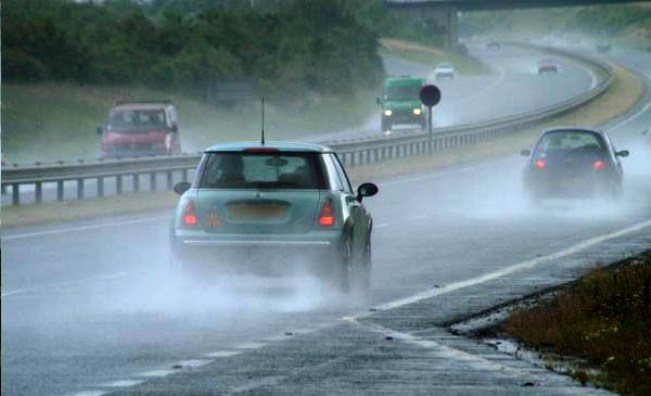It has been raining for a few week now, and it does not look like the rain will stop anytime soon. Driving in the rain can be a scary thing, and in the night, it is even worse. It is difficult to see out of the window, and the other car’s lights seems to make it worse. Especially when you begin to hydroplane! Here are things you should consider before and while driving in the middle of the rains and wet roads.
1. Avoid Flooded Roads.
Never drive through standing or flowing water in a road way unless you have no choice or you are able to follow someone else to judge the depth of the water. Flooding the engine of your car can cause the engine to stall, and deep water can actually float your car and take it off the roadway.
2. Keep A Safe Distance From Other Vehicles.
Keep a minimum of a good five car length from the car in front of you. You never know what other drivers are going to do or what could happen to you! If that feels too close or too far a rule of thumb is 1 second of following distance per 10 mph (16 km/h). That holds true especially in bad weather.
3. Be Aware Of Hydroplaning.
This is where your vehicle travels on top of the water and has NO or very little contact with the ground. Your traction is reduced significantly. To safely get out of a hydroplaning situation let off the gas and steer straight or slightly in the direction you must go. Do not make sudden motions and remain calm.
4. Turn On Your Headlights.
It is highly recommended to have your headlights on when it’s raining, even in broad daylight. This will make it easier for you to see what is in front of you; thus, preventing any accidents. You will be able to have clear visibility amidst the condition.
5. Keep Both Hands On The Steering Wheel At All Times.
Keep all distractions, such as cell phones or even the radio, off and away from you. While focus to your front do Take a Look in Back View Mirror as well Right Hand side & Left Hand side so that you get an 360 degree over view what is happening around any mud slide or falling tree, electric pole, hanging electrical wires , or in coming hazard.
6. Drive Slowly.
Have you ever seen a gritty rainbow film on the road? That’s oil and grime built up over the days and leaked from cars, do not pass by it especially when you’re approaching fast because it’s slippery. When you’re driving fast on rainy day, there is a greater chance that you hit the car ahead of you when you slip off the road.
7. Hazard Lights.
Only use your hazard lights when you think you can no longer drive with the flow of traffic, meaning you’re a ‘hazard’ to others. If you can keep up, keep your hazard lights off. If you push that red triangle button even when you’re still able to drive normally, you’re giving wrong (or no) signal to drivers on which direction you’re turning which can be dangerous.
8. Keep Attention To Tyre Inflation.
Your tires are your first line of defense; it should be taken serious care especially when the roads are getting slippery. Keep the right amount of inflation on your car tires. If the tyre becomes poorly-inflated or with lower pressure, you may loss control over your car while driving.
9. Adjust Your Driving Style.
Cast your mind back to your driving test, and you’ll remember that stopping distances increase in the wet. But can you remember by how much? In actual fact, it takes about twice as long to stop on a wet road as it does on a dry one. So you should increase the distance between you and the car you’re following by about that much.
10. Drive Only If It’s Necessary.
Yes, you’ve heard it on the weather forecast all the time, but people say it for a reason. Put simply, if you don’t go out, you can’t come to any harm on the road. Is your journey really that urgent or important? If not, it might be better to stay in, have a cup of tea, and wait until the rain passes.










